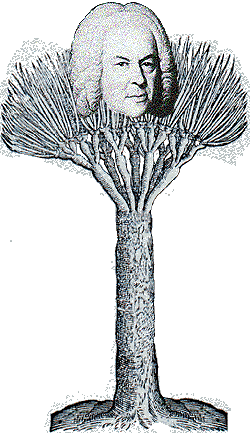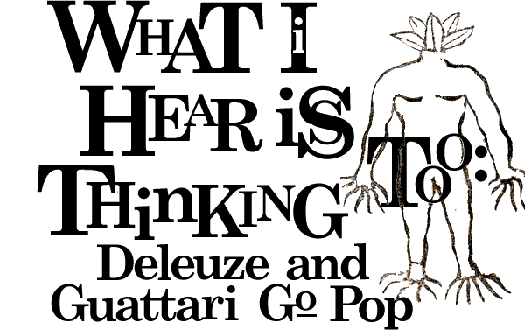- Of the many
forms of expression through which their thought moves, flowing
and multiplying without privilege or hierarchy, Gilles Deleuze
and Félix Guattari number "pop" among the most
powerful (in the Spinozian sense, of that which affords the greatest
potential for further connection and ramification). In what might
at first seem a wildly inappropriate context—their analysis
of Kafka's production of a "minor literature"—they
define "pop" as:
An
escape for language, for music, for writing. What we call
pop—pop music, pop philosophy, pop writing—Wörterflucht
[word flight]. To make use of the polylingualism of one's
own language, to make a minor or intensive use of it, to oppose
the oppressed quality of this language to its oppressive quality,
to find points of nonculture or underdevelopment, linguistic
Third World zones by which a language can
escape, an animal enters into things, an assemblage comes
into play. (Kafka 1986, 26-27)
"Pop,"
then, is for Deleuze and Guattari a form of multiplicity, a rhizome;
indeed, in A Thousand Plateaus they insist that "RHIZOMATICS
= POP ANALYSIS" (A Thousand Plateaus 24).1
The rhizome, of course, is their well-known image of a decentered
system of points that can connect in any order and without hierarchy,
a term drawn from botany that names a network of stems, like the
strawberry plant, that grows horizontally and discontinuously
by sending out runners.

Pop can be conceived as a rhizome because it develops by fits
and starts, in a messy, practical, improvisational way rather
than in a refined, programmatic, theoretical way. The logic of
the rhizome is opposed to that of the tree, which is a hierarchical
structure centered around a fixed root, a structure that grows
continuouslyand vertically(A Thousand Plateaus chapter
1). If pop is a rhizome, then it may be helpful to think of the
Germanic tradition of formal composition from Bach to Schoenberg,
 along
with the classical musicology that studies that tradition, as
an example of the linear tree system: a continuous sequence in
which each successive composer extends the rigorous line of harmonic
development established by the previous composers further in the
same direction. along
with the classical musicology that studies that tradition, as
an example of the linear tree system: a continuous sequence in
which each successive composer extends the rigorous line of harmonic
development established by the previous composers further in the
same direction.
- Although
a detailed comparative examination of the two models would certainly
be rewarding, it is beyond the scope of this essay. We have chosen
specifically to limit our discussion to the pop realm or regime,
defined as follows: the regime of music production that is tied
neither to the European composer/concert tradition and its strict
division of labor, nor to any of the various historical traditions
of indigenous music making around the world, but rather to the
bricolage of modern recording technology (electric/electronic
instruments, studios, overdubbing, mixing, etc.) and its media
of distribution. This definition of pop obviously has little to
do with the neo-Romantic "popist/rockist" genre distinction
that dominates many popular music studies, and even less to do
with market demographics; it’s intended to be a productivist
model that can in principle unite disparate phenomena like dub,
musique concrète, dance remixes, electronica, and
stadium rock along a coherent conceptual axis without necessarily
claiming that it can account for all the differences among these
phenomena. Because of the productivist nature of our model, we
will be dealing exclusively with recordings; recordings are the
unequivocally privileged form of production, distribution, and
consumption of this musical rhizome. We are not particularly interested
in whether the recordings in question sell ten or ten million
copies; pop in this sense is not essentially a quantitative term
but rather a qualitative one, just as it is not a marker of generic
distinction, but rather a productive potential of all music. This
is what Deleuze and Guattari’s claim concerning
"pop music, pop philosophy, pop writing" demands.
- Their functional
and differential theory of pop intersects with more traditional
critical definitions of the term at several points, but it also
escapes from tradition in a number of significant ways, and provides
contemporary musicians with new points of departure for musical
composition.2 Indeed,
we propose that any valid theory of contemporary music must be
similarly double: descriptive of existing musics, and enabling
of future musics. Deleuze and Guattari’s theory meets this
criterion. We will first lay out the descriptive elements of their
general theory of music, which must be assembled from a number
of published sources since Deleuze and Guattari never dedicated
a text exclusively to the exposition of their ideas on music.
A second descriptive section will also attempt to identify the
specific pop music artifacts and experiences from which Deleuze
and Guattari drew the key elements of their pop rhizome. This
will serve as a transition to the final section of our argument,
which will examine a number of electronic pop recordings explicitly
dedicated to Deleuze and Guattari in order to determine the ways
in which their theory has enabled innovative new forms of music
to arise.
|
|



